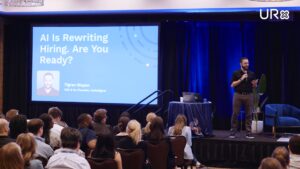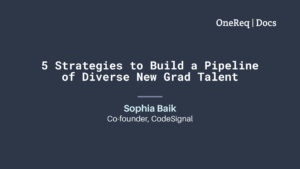BY: Sophia Baik
According to a 2021 study from Hack Future Lab, 93 percent of leaders agree diversity, equity, and inclusion (DE&) is a top priority at their company. However, only 34 percent believe it’s a current strength in their workplace.
One company that has turned their DE&I recruiting aspirations into strengths is Asana, a leading work management platform with over 1,000 employees. Their AsanaUP program provides apprenticeship opportunities to technical candidates from nontraditional and underrepresented backgrounds. And, it works—AsanaUP has a success rate of 82% when it comes to converting apprentices to full-time software engineering roles.
Sophia Yamauchi leads the AsanaUP program and, in a recent webinar with CodeSignal, gives advice for other companies looking to build a recruiting DE&I program.
1. Start with the “why”
When advocating for DE&I with other stakeholders in the business, think about how it aligns with your core values and goals as an organization. “Asana’s mission is to help humanity thrive by enabling the world’s teams to work together effortlessly,” Yamauchi explains. “In order to fulfill this mission, it’s imperative that we build a diverse team that’s representative of the customers we support each and every day.”
Think about how your DE&I program goals drive toward the overall mission of your company, and clearly define your goals for creating opportunities for people from nontraditional or underrepresented communities.
2. Gain support from leaders, managers, and mentors
A program like AsanaUP takes support from all across your organization to succeed. Each AsanaUP apprentice gets a support team consisting of a manager, a mentor, and an additional team member. In addition to 1:1 mentorship, apprentices can lean on groups outside of their team, like Employee Resource Groups (ERGs) and the AsanaUP alumni. The program also organizes lunch-and-learns and ongoing sessions on topics like dealing with imposter syndrome, how to network, and how to ask for help.
To foster this kind of community, Yamauchi says, “it’s really important to find the people that are really excited about investing their time and putting forth the effort to help those who are trying to break in from nontraditional backgrounds.”
3. Partner with organizations that can help you source diverse candidates
A frequently-cited challenge with implementing DE&I is the candidate pipeline: how do you get the right candidates into the program? One way is to seek out organizations that are already investing in upleveling and upskilling the kinds of individuals your company is hoping to connect with.
AsanaUP has partnered with the Marcy Lab School and Year Up, two organizations that are very intentional about closing the opportunity gap in tech. The Marcy Lab School provides rigorous but affordable college alternatives to propel underestimated young professionals to a rewarding career in tech. Year Up’s mission is to close the opportunity divide by ensuring that young adults gain the skills, experiences, and support that will empower them to reach their potential.
4. Ensure candidates have equal opportunities to succeed
While external partnerships are one way to create structure around your program, it’s also important to introduce structure to your hiring funnel to ensure all candidates have an equal opportunity to succeed.
For Asana, this includes taking a look at how they’re setting the minimum threshold score for the technical assessment portion of the interview. “We don’t expect that our apprentices are meeting the same bar as candidates that have a 4-year CS degree,” Yamauchi explains.
5. Align your team on what success looks like
A final secret to AsanaUP’s 82% conversion rate is setting clear goals for apprentices and their managers. Every apprentice will walk through a success guide with their manager that outlines the criteria and competencies needed to convert to a full-time role.
Apprentices have the opportunity to request feedback anytime, but the program also provides frequent rounds of structured feedback. “We look at how they’ve made an impact, areas for growth and improvement, are they on track — and if not, what can we all do as a team to help them get there,” Yamauchi says. “It’s a two-way conversation, so they can share their feedback on their experience as well.”
As you expand your DE&I focus this year, CodeSignal can help! Schedule for a free demo to learn about how structured technical interviews can fight bias and level the playing field for your candidate pool.
About the Author
Sophia Baik is Co-founder and VP of People, Finance, and Operations at CodeSignal, a coding skills assessment platform dedicated to helping companies #GoBeyondResumes in tech recruiting. Prior to co-founding CodeSignal, Sophia started her career in investment banking at Lehman Brothers before gaining experience in marketing and operations at tech companies such as Wayfair, Zynga, and Beepi. Sophia earned a master’s degree in business administration from the Massachusetts Institute of Technology (MIT) Sloan School of Management and a BA in Economics from Carleton College.




